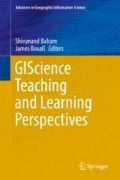Abstract
With the prevalence of the Internet and mobile devices, the visualization and presentation of geographical data are not limited to paper-based maps anymore. Geographical Information Science (GIS) web services are the software components that host spatial data and GIS functionalities that can be accessed and integrated into customized GIS applications through the Internet. Developers utilize GIS web services for custom applications that process geographical information without having to maintain a full GIS system or the associated spatial data. Two key benefits of web-based GIS distribution systems are the increased interaction with users and connections to a wider audience and its advanced data integration capabilities. With a number of projects and cases in Canada, the potential of Web GIS is demonstrated from a research perspective in the fields of migration, communication, culture, etc. The fast development of Web GIS will not only help improve the research in academia but also has the potential to benefit public society as a whole. Therefore, the transmission of capabilities in Web GIS to students via university teaching is also discussed. Web GIS has brought up inexorably changes to the teaching of GIS. These changes present both opportunities and challenges for educators and students.
Access this chapter
Tax calculation will be finalised at checkout
Purchases are for personal use only
References
Baker, T. R. (2005). Internet-based GIS mapping in support of K-12 education. The Professional Geographer, 57(1), 44–50.
Bloom, B. S., & Krathwohl, D. R. (1984). Taxonomy of educational objectives book 1: Cognitive domain. New York: Addison Wesley Publishing Company.
Brown, G. (2012). An empirical evaluation of the spatial accuracy of public participation GIS (PPGIS) data. Applied Geography, 34, 289–294.
Environmental and Social Systems Analysts Ltd. (1982). Review and Evaluation of Adaptive Environmental Assessment and Management. Vancouver: Environment Canada.
Fu, P., & Sun, J. (2010). Web GIS: Principles and applications. Redlands, CA: ESRI Press.
Healey, M., & Jenkins, A. (2000). Kolb’s experiential learning theory and its application in geography in higher education. Journal of Geography, 99(5), 185–195.
Holling, C. S. (1978). Adaptive environmental assessment and management. London: John Wiley & Sons.
Kulawiak, M., et al. (2010). Interactive visualization of marine pollution monitoring and forecasting data via a Web-based GIS. Computers & Geosciences, 36(8), 1069–1080.
Kyem, P. A. K., & Saku, J. C. (2009). Web-based GIS and the future of participatory GIS applications within local and indigenous communities. The Electronic Journal of Information Systems in Developing Countries, 38(7), 1–16.
Li, S., et al. (2011). Advances in web-based GIS, mapping services and applications. Boca Raton: CRC Press.
Manson, S., et al. (2014). Resource needs and pedagogical value of web mapping for spatial thinking. Journal of Geography, 113(3), 107–117.
Mesev, V. (2007). Integration of GIS and remote sensing. West Sussex, UK: John Wiley & Sons Ltd.
Mingyi, D., et al. (2013). Educational geographic information system based on WebGIS. Information science and cloud computing companion (ISCC-C), 2013 international conference on.
Onwuegbuzie, A. J., et al. (2010). Innovative data collection strategies in qualitative research. The Qualitative Report, 15(3), 696–726.
Sui, D. Z. (1995). A pedagogic framework to link GIS to the intellectual core of geography. Journal of Geography, 94(6), 578–591.
Tomlinson, R. F. (2007). Thinking about GIS: geographic information system planning for managers. Redlands, CA: ESRI.
Tsou, M.-H., et al. (2005). A web-based java framework for cross-platform mobile GIS and remote sensing applications. GIScience & Remote Sensing, 42(4), 333–357.
Walters, C. (1986). Adaptive management of renewable resources. New York: Macmillan Publishing Company.
Wang, J., et al. (2015). A WebGIS-based teaching assistant system for geography field practice (TASGFP). British Journal of Educational Technology, 47, 279–293.
Author information
Authors and Affiliations
Corresponding author
Editor information
Editors and Affiliations
Rights and permissions
Copyright information
© 2019 Springer Nature Switzerland AG
About this chapter
Cite this chapter
Han, R. (2019). Web GIS in Development: From Research and Teaching Perspectives. In: Balram, S., Boxall, J. (eds) GIScience Teaching and Learning Perspectives. Advances in Geographic Information Science. Springer, Cham. https://doi.org/10.1007/978-3-030-06058-9_7
Download citation
DOI: https://doi.org/10.1007/978-3-030-06058-9_7
Published:
Publisher Name: Springer, Cham
Print ISBN: 978-3-030-06057-2
Online ISBN: 978-3-030-06058-9
eBook Packages: Earth and Environmental ScienceEarth and Environmental Science (R0)

